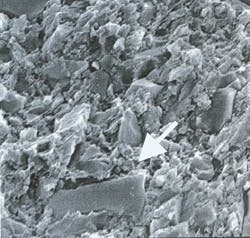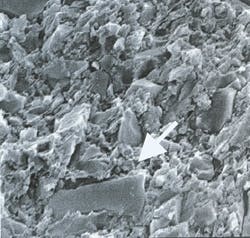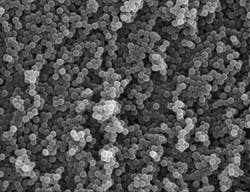Interaction between nanoparticles and glass ceramic with a defined grit
How to achieve a filler content of 89% by weight
by Martin Danebrock, PhD
For more information on this topic, go to www.dentaleconomics.com and search using the following key words: nano particles, microfilled composites, hybrid composites, micro-hybrid composites, nano composites.
In the past 10 to 20 years, many advances have been made in the area of dental restoratives. Direct and indirect tooth-colored restorations are now the patient-preferred restorative.
Conventional composites differ mainly in the type and size of fillers used. Fillers with medium-sized particles of approximately 10 micrometers (µm) are used in macrofilled composites, the first tooth-colored plastic fillers of this type to be developed. Because large particles have a very good surface/volume ratio, they produce relatively highly filled composites with reasonable degrees of shrinkage.
However, these materials have only moderate fracture resistance and exhibit inadequate abrasion resistance due to the lack of homogeneity between the resin matrix and filler particles. They are also very difficult to polish, thus limiting their use in the anterior region.
Microfilled composites were developed to provide improved polishing properties. The fillers used in these composites are pyrogenic silica, which is produced using a special process called flame pyrolysis.
The primary particle size of these fillers is between 10 and 50 nanometers (nm). These are not individual particles, but they are always found in the form of agglomerates.
The advantage of these microfilled composites is that the fillers are uniformly embedded in the resin matrix, making it easy to polish them to a high luster. However, the surface/volume ratio of these fillers is most unfavorable, creating comparatively low filler content.
This results in high levels of volumetric shrinkage during polymerization, which can restrict their use to small cavities or cavities with a lower C-factor, such as cervical defects and anterior fillings.
Moderate fracture and abrasion resistance, coupled with low radiopacity levels, further limit the use of these materials. Attempts to increase the filler content by adding prepolymerized particles did improve the physical properties, though not enough to make these materials suitable for permanent restorations in the posterior region.
The most widely used filling materials of this type are hybrid composites. These have been used successfully in all cavity classes throughout the anterior and posterior regions since the early 1990s. The term “hybrid” relates to the mixture of macro- and microfillers.
Fig 1: Conventional fillers produced by milling. The particles are in the form of splinters, so the milled fillers vary greatly in size.
Macrofillers, which generally consist of milled glass porcelain, provide the material with the required physical resistance. Microfillers fill the gaps between the macrofiller particles, and improve both the wear-resistance and polishing properties.
Additional advances in milling techniques also enabled the size of the macrofillers to be reduced from an initial 10 µm to sizes below a single micron. The latest generation of these materials — i.e., ultra-fine hybrid or micro-hybrid composites — use particles with an average grit size in the submicrometer range (average particle size approx. 0.7 µm).
The size of the particles is dependent upon the milling technique and the viscosity of the pastes (resins), and are affected to a degree by the random, splinter shape and large surface of the particles (see Fig. 1).
The latest innovations are nano composites. In nano technology, particles are produced using a new technique. Grit size is no longer determined by simple milling.
The particles are created from different components using SolGel chemistry. The creation process is controlled and terminated at a specific point so that spherical particles of a precisely defined grit size (e.g., 20 nm) and composition are produced (see Fig. 2).
These nanoparticles have completely new properties when compared with conventional particles. Their properties are more similar to those of a liquid than those of a solid. This means that they do not thicken a resin matrix the way conventional fillers do. Composite resins can be synthesized with up to 50% nanofillers, which have virtually the same viscosity as pure, unfilled resin.
3M ESPE has developed Fitek Surpreme using nano- fillers and nanoclusters. VOCO GmbH in Germany has manufactured GrandioSO nanohybrid composite, based on this pre-nanofilled resin with the addition of glass porcelain.
The interaction between nanoparticles and glass porcelain with a defined grit size results in excellent volumetric saturation of the fillers in GrandioSO. This produces unprecedented unique filler content for hybrid composites of 89% by weight (73% by volume).
The actual increase in filler content is particularly evident when the filler content is viewed in relation to the proportion of resin. While the ratio of resin (approximately 20% by weight) to filler (approximately 80%) is 1:4 in conventional hybrid composites, the ratio is 13:87 — i.e., 1:6.7 — in Grandio.
This significant increase in filler content has resulted in a definite improvement in all physical properties, such as fracture resistance, surface hardness, and abrasion-resistance. Minimizing the resin content has also led to a marked reduction in polymerization shrinkage by as much as 50% in comparison to current conventional hybrid composites. It has also led to a reduction of staining.
More and more companies are coming out with nano composites, but what is a real nano composite? The current discussion in research is about the definition. Are nano composites defined as composites with any kind of nano-sized elements or are nano composites viewed as those with a significant amount of nano fillers such as Filtek Surpreme or GrandioSO?
Martin Danebrock, PhD, is an independent chemical and materials engineer in Cuxhaven, Germany. His devotion to the study of dental materials has made him a much sought after resource throughout Germany. He prides himself on extensive testing and scientific data to reach his findings. He has worked with various companies and universities throughout Germany. He may be contacted by email at [email protected].


